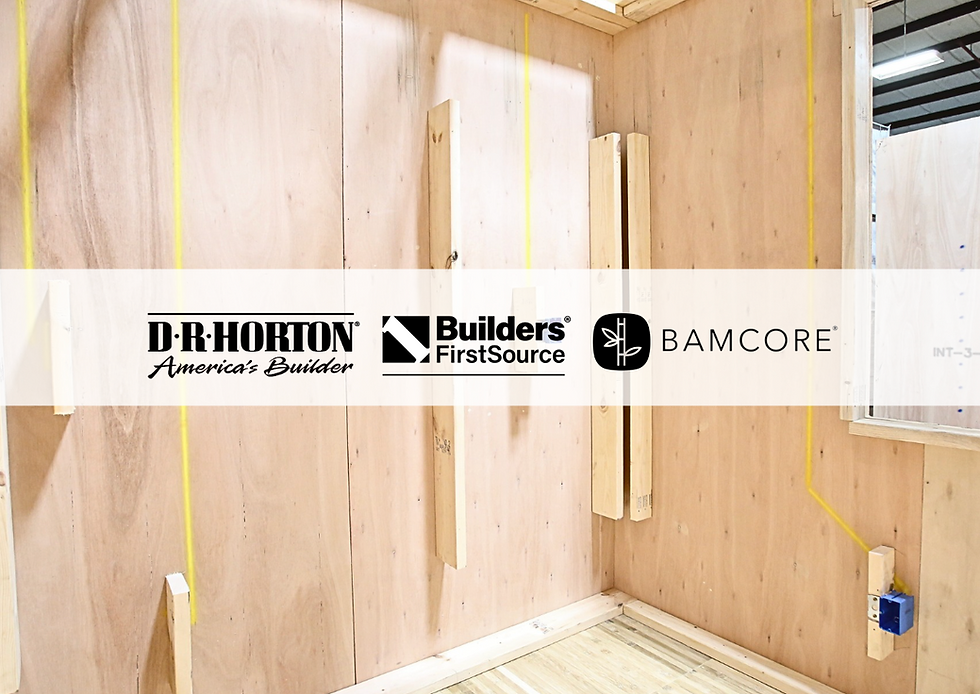Building for Tranquility
- Tobe Sheldon

- Jul 19, 2023
- 3 min read
Updated: Aug 7, 2023
The Impact of Noise Pollution on Your Health and BamCore's Role in Silencing the Chaos

Building for Tranquility Begins with Your Building Envelope
During a recent visit to the River Run multifamily development by Concord Homes Utah, we had an opportunity to experience first-hand how BamCore contributes to fostering a peaceful home environment. River Run provided a unique platform for comparison, as it incorporates both traditional stick-built units and units erected using the BamCore Prime Wall™. This configuration enabled us to evaluate and compare sound attenuation in a real-world context.
In our informal test, the BamCore units registered a remarkably low sound level of 27dB – just below a whisper on the Decibel Scale. In contrast, the traditional stick-framed units recorded a noise level of 37 dB. Despite both types of units adhering to the same 52 Sound Transmission Class (STC) standard, the BamCore units delivered an undeniable sense of serenity. This is attributed to the BamCore Prime Wall™'s ability to eliminate up to 90% of the cross members responsible for thermal and acoustic bridging.
Describing the distinctive tranquility of a BamCore building is one thing, but it's an experience that truly has to be felt to be fully appreciated. With the dB readings, we now have quantifiable evidence of the difference. In terms of noise levels, BamCore falls into the 'faint' category compared to the 'soft' category for traditional stick-built units. We are keenly awaiting the publication of the official third-party testing results.
Decoding Sound and Noise
At its core, sound is energy that traverses through the air, perceived by our ears as minor fluctuations in air pressure. The more energy you put into creating a sound, the louder it will be.
Noise is sound that we don't want or find disruptive. This could range from a dog's relentless barking to persistent car alarms. Interestingly, even agreeable sounds can turn into noise when their volume increases. Therefore, noise is a concept that involves both a physical, measurable component and a subjective one, which depends on an individual's personal perception or reaction to a particular sound.
What is a Decibel?
Originating from the early 20th century, the term 'decibel' traces back to power measurements used in the US Bell System's telephony. The unit was initially used to quantify power losses during the transmission of telegraph and telephone signals via long cables. A decibel represents a logarithmic ratio between a measured value and a reference value, with one decibel being a tenth of one bel – a nod to the unit's namesake, Alexander Graham Bell.
How Does the Decibel Scale Work?
The decibel scale starts at near-complete silence, measured as 0 dB. It's a logarithmic scale, which means a sound 10 times greater in intensity than silence is 10 dB, a sound 100 times more intense is 20 dB, a sound 1,000 times greater is 30 dB, and so on. Here are some examples to provide context:
Near complete silence: 0 dB
BamCore built living room (informal test): 27db
Whisper: 30 dB
Stick-built living room: 35 db
Library: 40 dB
Normal conversation: 60 dB
Heavy city traffic: 85 dB - The threshold where hearing damage can occur
Lawn mower: 90 dB
Noisy restaurant: 90 dB
Baby crying: 110 dB
Sirens: 120 dB
Sporting events: 105 to 130 dB (depending on the stadium)
Fireworks: 140 to 160 dB
Firearms: 140 dB and higher

The Unseen Consequences of Noise Pollution on Health
The American Public Health Association (APHA) reveals a worrying reality: exposure to detrimental noise levels is alarmingly pervasive. This noise, emanating from sources like transportation systems, industrial machinery, and even leisure activities, can insidiously impact our well-being. Sure, we're all familiar with how loud noises can cause hearing issues such as tinnitus, but the effects run deeper. Chronic exposure to even low-level noise can trigger a cascade of health issues, from sleep disruption and heightened stress levels to cardiovascular disease and metabolic disturbances. More disturbingly, these issues could exacerbate psychological disorders. Over 100 million Americans are currently at risk, with children being alarmingly susceptible. The health-related expenses from noise pollution are astronomical, skyrocketing into the hundreds of billions of dollars annually. Thus it pays to invest in building for tranquility.
As we continue to grapple with the effects of noise pollution on health, innovative solutions like BamCore’s Prime Wall™ system can play a pivotal role in helping to create a more tranquil and healthy living environment. By prioritizing noise reduction in our designs, we can take a step towards making our homes true sanctuaries – a vital need in today's bustling world.




Comments